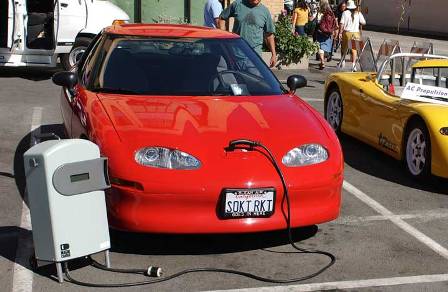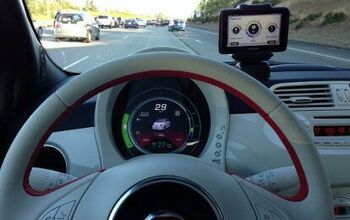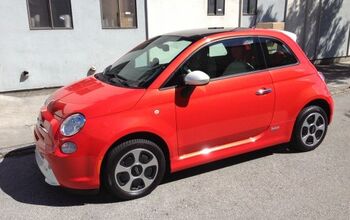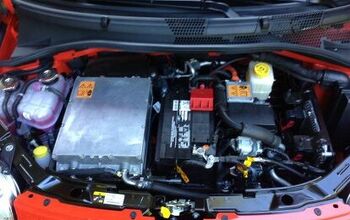Living With an EV for a Week - Day Seven (EV Death and Resurrection)

It was the end of the line for the orange creamsicle Fiat 500e dubbed Zippy Zappy. She and I covered some 675 miles together during our seven-say odyssey (if you don’t know what I’m talking about, click over to Day 1, Day 2, Day 3, Day 4, Day 5, Day 6 before coming back to the saga, I promise we’ll wait for you.) As I ended my afternoon commute by rolling silently through my forest, I looked down at the power gauge. 33% left. It had been a hot day so I had the A/C on, cruise control set to 74 MPH and Toby Keith was blaring on the radio. My range anxiety was gone. But had some EV mystique been lost in the process?
When the LEAF floated down to the forest floor for the first time in early 2011 it truly was the start of something new. Where this 21st century EV adventure will take us is anyone’s guess, but the LEAF represented the first viable electric car in nearly 100 years and single-handedly boosted EV sales in America to the highest numbers since 1914. Yes, I am discounting the EV1, the original RAV4 EV, Honda EV Plus and the S-10 EV. Why? Well, being horrible cars doesn’t help their case, and aside from that, put together they totaled around 3,000 over eight model years. Talk about dismal sales. Oh wait, most of them weren’t sold, they were leased as “experimental research vehicles.” Before we end our EV week, we need to talk about the 1990s EV blip.
Who killed the EV in 1999? Nobody. Sorry Chris Paine and the other conspiracy theorists, the EV was stillborn at the end of the 20th century and all the zapping from MagneCharge paddles couldn’t get that dog to hunt. (Oh how I love mixing metaphors.) What was the real issue? Let’s start at the beginning.
The EV1 was dreadfully ugly. Ugly cars don’t sell well. The EV1 was also a two-seat coupé. Two-seaters don’t fly off showroom floors. Toss in shopping cart like handling when the market clamored for go-kart manners, limited range, ginormous/expensive home charging stations, and lead-acid batteries that have a limited lifetime and you had a car no sane shopper would want to own. So GM leased them for $399-$549 a month ($576-$793 in 2013 dollars). The Gen II EV1 (why didn’t they call it an EV2?) landed in 1999 with NiMH batteries. GM traded the lead battery weaknesses for higher energy density (30% more capacity for the same weight) and a different set of problems. NiMH batteries were all the rage in the 90s—our Motorola cell phones and “luggable” laptops used them—but they “self-discharge” far more rapidly than other battery types and are more fickle about charging temperatures. Because of the nature of NiMH packs a beefier cooling system was needed to keep them happy while charging. Charge times doubled from 4 hours to 8 hours at 240V and the 120V “opportunity” charger had to be abandoned since the car’s new battery cooling system consumed nearly 1,000 watts meaning you could run the cooling, or charge. Not both. Toss in huge losses on every car sold, no desire to extend losses by making out of warranty parts and GM killed the endeavor 1,117 cars later. Thank God. Who killed the EV1? Who cares? It was a mercy killing and I believe in euthanasia.
How about the RAV4 EV? 0-60 in 18 seconds, a top speed of 78MPH, limited range and a steep $42,000 price tag ($60,680 in 2013 dollars = ouch). Following the death of the EV1 program, GM sold their battery division which held key NiMH patents used by automotive battery makers. Regardless of the conspiracy theories surrounding the Chevron ownership of patents and the closing of the large battery division, so few EVs were being made we can never be sure about the motivation for stopping production. Does it matter? Probably not since the market for a slow, heavy compact 2WD trucklet that cost more than twice the base price of a gasoline version was limited to say the least. In addition, the home charger for the EV1 and RAV4 cost $2,500 in 1996 ($3,611 adjusted for inflation), lease payments were steeper than a Cadillac, and gasoline cost $0.99 a gallon. Which would you have picked? The fact that any of these cars got off the ground in the first place is a testament to two things: 1. California’s legislative powers can move mountains. 2. There’s an ass for every seat.
What does that have to do with my week in Zippy Zappy? I’m amazed how far we’ve come in just 16 years. Battery technology has improved by leaps and bounds thanks to the boom of portable widgets in the last 10 years. Batteries aren’t just more energy dense, they are more durable, safer and have faster charge/discharge rates. These improvements allow EVs to be made that don’t weigh substantially more than a regular car, can handle like a regular car, look like a regular car and drive like a regular car. Thanks to other improvements we have lower charging times and smaller connectors. We also have 240V home charging stations that cost $450, one eighth the cost of the EV1’s funky paddle system and use up 1/20th the physical space.
Much of what was learned in the EV programs at the end of last century has been applied, not just to modern EVs from Zippy Zappy to the Model S, but to hybrid cars and normal cars alike. Hybrid cars accounted for 3.4% of new vehicle sales last month and 6.5% of new car sales. (Pure EVs? 0.54% of new car sales in May.) Those hybrids have built on EV lessons, from battery-powered climate control systems to aerodynamic improvements and power management systems. The next big thing (if you listen to some people) will be fuel cell vehicles which will build further on the EV lessons learned. Fuel cells are exciting in many ways but they need batteries because fuel cells work best when delivering a constant flow of power. The cells depend on the “ballast” ability of a battery to supply peak loads like going up hill or accelerating rapidly.
The more I drive EVs, the more the veil has descended. EVs are wrapped up in green clothing, range anxiety, conspiracy theories and more, but at their heart, they are just a regular car with a cord and a small fuel tank. If (and when) people begin to see EVs for what they are (and what they aren’t) I think we’ll see more of them on the roads. They won’t keep minke whales from being hunted down on Whale Wars. With our current power generation make up they are unlikely to have much of an impact on greenhouse gas emissions. But as long as they fulfill the promise of reduced overall emissions and low operating costs, they will have a home with commuters looking for silent running. Next time I need a new car, an EV will certainly be on my list. Where on the list? Good question.
Looking for the other installments? Here you go:

More by Alex L. Dykes
Latest Car Reviews
Read moreLatest Product Reviews
Read moreRecent Comments
- Analoggrotto I don't see a red car here, how blazing stupid are you people?
- Redapple2 Love the wheels
- Redapple2 Good luck to them. They used to make great cars. 510. 240Z, Sentra SE-R. Maxima. Frontier.
- Joe65688619 Under Ghosn they went through the same short-term bottom-line thinking that GM did in the 80s/90s, and they have not recovered say, to their heyday in the 50s and 60s in terms of market share and innovation. Poor design decisions (a CVT in their front-wheel drive "4-Door Sports Car", model overlap in a poorly performing segment (they never needed the Altima AND the Maxima...what they needed was one vehicle with different drivetrain, including hybrid, to compete with the Accord/Camry, and decontenting their vehicles: My 2012 QX56 (I know, not a Nissan, but the same holds for the Armada) had power rear windows in the cargo area that could vent, a glass hatch on the back door that could be opened separate from the whole liftgate (in such a tall vehicle, kinda essential if you have it in a garage and want to load the trunk without having to open the garage door to make room for the lift gate), a nice driver's side folding armrest, and a few other quality-of-life details absent from my 2018 QX80. In a competitive market this attention to detai is can be the differentiator that sell cars. Now they are caught in the middle of the market, competing more with Hyundai and Kia and selling discounted vehicles near the same price points, but losing money on them. They invested also invested a lot in niche platforms. The Leaf was one of the first full EVs, but never really evolved. They misjudged the market - luxury EVs are selling, small budget models not so much. Variable compression engines offering little in terms of real-world power or tech, let a lot of complexity that is leading to higher failure rates. Aside from the Z and GT-R (low volume models), not much forced induction (whether your a fan or not, look at what Honda did with the CR-V and Acura RDX - same chassis, slap a turbo on it, make it nicer inside, and now you can sell it as a semi-premium brand with higher markup). That said, I do believe they retain the technical and engineering capability to do far better. About time management realized they need to make smarter investments and understand their markets better.
- Kwik_Shift_Pro4X Off-road fluff on vehicles that should not be off road needs to die.





































Comments
Join the conversation
>>Once the battery is depleted it will operate just like a Prius and C-MAX with some major software tweaks.
I finally got around to reading this series and I now think I understand EVs a little better and how they may or may not fit into my car future. Thanks.